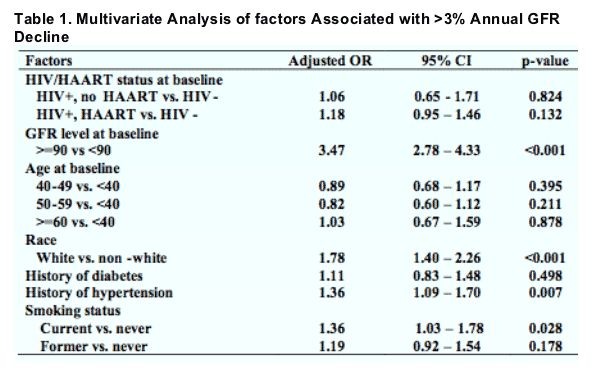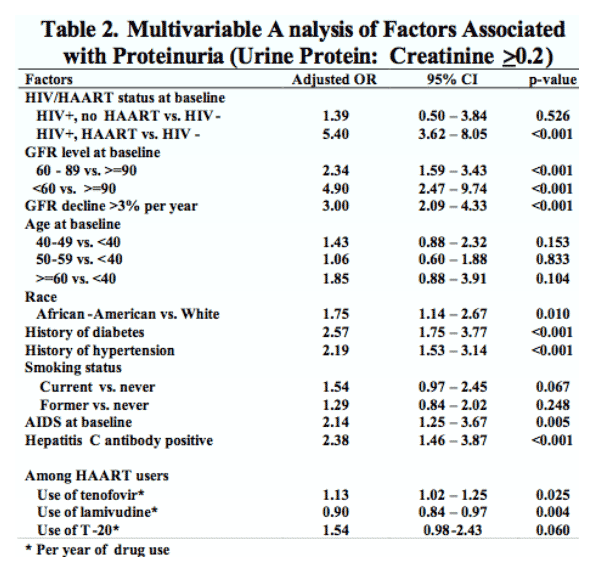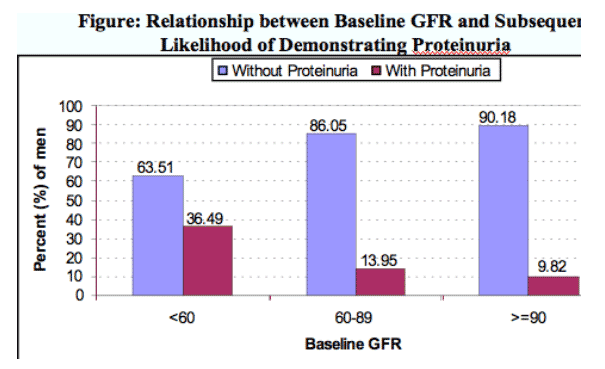 |
 |
 |
| |
Kidney - Proteinuria, Glomerular Filtration Rate Reductions, and Associated Factors among HIV-Infected and Uninfected Men in the Multicenter AIDS Cohort Study (MACS)
|
| |
| |
Reported by Jules Levin
15th CROI, Feb 3-6, 2008, Boston
FJ Palella Jr1 , X Li2, L Kingsley3, S Gupta4, Roger Detels5, Joseph Margolick2, John Phair1, and Lisa Jacobson2
1Northwestern University Feinberg School of Medicine, Chicago, IL, USA; 2Johns Hopkins University, Baltimore, MD, USA; 3University of Pittsburgh, Pittsburgh, PA, USA; 4Indiana University School of Medicine, Indianapolis, IN, USA; 5University of California at Los Angeles, Los Angeles, CA, USA.
"Proteinuria is a more sensitive sign of early renal disease in HIV+ persons than GFR declines and non-HIV causes of renal disease predominate."
AUTHOR CONCLUSIONS
1. Declines in GFR were associated with neither HIV serostatus nor HAART use, despite the fact that HIV-infected HAART recipients more often had low baseline GFR's than HIV seronegative men.
2. However, proteinuria was:
a) five times more common among HIV-infected men receiving HAART than HIV uninfected men
b) strongly associated with GFR declines regardless of HIV serostatus
c) associated with tenofovir use and T-20 (enfuvirtide) use (perhaps a surrogate for advanced HIV
d) more common in men with classic risks for renal disease (eg. hypertension, diabetes, smoking, AIDS, chronic co-infection with hepatitis C virus)
e) a more sensitive sign of early renal disease in HIV-infected persons than GFR
declines, with non-HIV causes of renal disease predominating
ABSTRACT
Background: Renal disease is common among HIV+ persons. Comparisons of factors affecting renal function among HIV+ vs HIV- persons are needed.
Methods: We evaluated longitudinal GFR changes, estimated using the Modified Diet in Renal Disease (MDRD) equation, and prevalence of proteinuria (PU, defined as a urine protein to creatinine ratio of >0.2) and associated factors among HIV+ and HIV- men participating in the Multicenter AIDS Cohort Study, a study of U.S. gay men.
Results: We analyzed GFR changes among 2163 men (1206 HIV-, 852 HIV+ on HAART, 105 HIV+/no HAART), each with >3 GFR assessments from 10/03-3/07.
GFR at baseline (BL) was >90 for 50.2%, 60-90 for 45.5% and <60 for 4.4% of men. 5.9% of HIV+ on HAART men vs 3.6% of HIV- had BL GFR <60, (p<0.001).
In logistic regression analyses factors associated with >3% GFR decline per year were BL GFR>90 (OR=3.5, p<0.001), white race (OR= 1.8, p<0.001), current smoking (OR= 1.4, p=0.028) and hypertension (OR=1.4, p=0.007).
HIV stage (CD4, HIV RNA), HAART use (including specific ARV's), age, and diabetes (DM) were not associated with GFR declines.
Men with GFR declines more often exhibited subsequent PU (OR= 3.1, p < 0.001). Median annual GFR change for men with PU was larger (-1.3%/yr) than men without PU (0.4%/yr), p<0.001. PU existed in 226 (12.6%) of 1800 men with data: 161(23.4%) of the HIV+/on HAART men, 6 (7.5%) of HIV+/no HAART men, and 48(5.3%) of HIV- men.
27(36.5%) of the BL GFR<60 group, 106(14%) of the BL GFR 60-90 group, and 82(9.8%) of the BL GFR>90 group had PU.
Factors associated with PU were: GFR 60-90 vs >90, (OR 2.34, p<0.001); GFR<60 vs >90 (OR 4.9, p<0.001); >3% GFR decline (OR 3.00, p<0.001); being HIV+ on HAART vs HIV- (OR 5.4, p<0.001); black race (OR 1.75, p=0.01); DM (OR 2.57, p<0.001); hypertension (OR 2.19, p<0.001); current smoking (OR 1.5, p=0.067); baseline AIDS (OR 2.1, p=0.005); HCV Ab+ (OR 2.38, p<0.001); tenofovir use (OR 1.13 per year of use, p=0.025); and T-20 use (OR 1.54 per year of use, p=0.06).
Conclusions: GFR decline was associated with neither HIV serostatus nor HAART use, despite that HIV+ HAART recipients more often had low BL GFR than HIV- men. However, PU was:1) 5 times more common in HIV+ men on HAART than HIV- men; 2) strongly associated with GFR declines regardless of HIV serostatus; 3) associated with TDF and T-20 use and; 4) more common in men with classic risks for renal disease (eg. AIDS, HCV). PU is a more sensitive sign of early renal disease in HIV+ persons than GFR declines and non-HIV causes of renal disease predominate.
Background
Renal disease has emerged as an important cause of preventable morbidity among HIV-infected persons. Calculated glomerular filtration rate (GFR) estimates and urine protein:creatinine ratios are sensitive and complementary indices of renal function. Comparisons of factors affecting renal function among HIV-infected and non-persons are needed.
The Cohort
This analysis was based on MACS data as of October 2007.
The MACS is an ongoing multi-center prospective observational study of men who have sex with men (MSM) that was established by the National Institutes of Health in 1984. MACS sites are in Baltimore MD, Chicago IL, Los Angeles CA, and Pittsburgh PA.
MACS participants are seen semi-annually at which time they undergo interviews, physical examinations and blood draws. Sera and cells have been collected at each visit .
Analytic Methods
We evaluated longitudinal GFR changes, estimated using the Modified Diet in Renal Disease (MDRD) equation, among HIV-infected and uninfected MACS participants who underwent at least three GFR assessments during the time period 10/03-3/07.
We measured the prevalence of proteinuria, defined as a urine protein:creatinine ratio of >0.2, and factors associated with proteinuria among HIV seropositive and seronegative MACS participants underwent urine pro:Cr measurements during the time period 4/06-3/07.
Results
GFR analysis
We analyzed GFR changes among 2163 men:
-1206 HIV-uninfected
-852 HIV-infected receiving HAART
-105 HIV-infected, not receiving HAART
GFR at baseline was:
>90 for 50.2% of men
60-90 for 45.5% of men
<60 for 4.4% of men
5.9% of HIV-infected men receiving HAART vs 3.6% of HIV-uninfected men
had baseline GFR <60, (p<0.001)
In multivariable logistic regression analyses factors associated with >3% GFR decline per year were baseline GFR>90, white race, current smoking, and a history of hypertension (see Table 1).
HIV stage (CD4 cell count, plasma HIV RNA levels), HAART use (including specific antiretrovirals), age, and a history of diabetes were not associated with GFR declines.


Proteinuria Analysis
Proteinuria existed in 226 (12.6%) of 1800 men with available data: 161(23.4%) of the HIV-infected men receiving HAART, 6 (7.5%) of HIV-infected men not receiving HAART, and 48(5.3%) of the HIV uninfected men.
27(36.5%) of the baseline GFR<60 group, 106(14%) of the GFR 60-90 group, and 82(9.8%) of the BL GFR>90 group had proteinuria (see figure)
In multivariable analyses factors associated with proteinuria were: baseline GFR 60-90 vs >90, baseline GFR<60 vs >90 , >3% annual GFR decline; being HIV-infected and receiving HAART vs HIV uninfected, black race, having a history of diabetes, a history of hypertension, current smoking, AIDS at baseline, having hepatitis C virus serum Ab, using tenofovir or T-20 (enfuvirtide)
Men with annual GFR declines of >3% more often exhibited subsequent proteinuria (OR= 3.1, p< 0.001)
Median annual GFR changes for men with proteinuria were greater than for men without proteinuria (-1.3%/yr vs 0.4%/yr, respectively, p<0.001)

|
| |
|
 |
 |
|
|